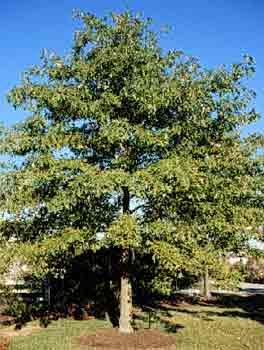Quercus coccinea
Scarlet Oak
Scarlet oak is a member of the red oak group with lobed leaves and is valued for its ornamental attributes as well as its fine wood. It is considered an excellent alternative to the overplanted pin oak because it is beautiful throughout the year and tolerates alkaline soil.
Leaves are simple, alternate, and deeply pinnate with seven to nine pointed lobes. The foliage is shiny and offers some of the best fall color of all the oaks. Fruits are a nut (acorn), partly enclosed by the persistent involucre -- the acorn cup. The acorn cup is turbin-shaped and smooth inside. The acorns mature at the end of the second season and sprout at the beginning of the third.
Additional Information:
Height
50-75 Feet
|
 |
Spread
40-50 Feet
|
USDA Hardiness Zone 4-8
Home Owner Growing and Maintenance Tips:
Scarlet Oak is a stately shade tree for the lawn, particularly in drier locations, with excellent fall color. Also a good street tree. Since it is a large tree, it must be planted in a location where it will have sufficient space to grow upward and spread to its mature size.
It thrives in full sun and well-drained, acidic soil. This tree is less susceptible to chlorosis problems than Pin Oak. Potential problems on oaks in general include obscure scale, two-lined chestnut borer, bacterial leaf scorch, oak horn gall and gypsy moth. In addition, as little as one inch of fill soil can kill an oak.
Characteristics & Attributes
Hydrologic Designation
|
Season of Interest
|
Soil Moisture
|
Special Features
|
Sun Exposure
|
USFS MO Ecological Map
|
Wildlife Benefit
| • |
Food/Birds |
| • |
Cover |
| • |
Food/Small Animals |
| • |
Nesting |
|
Printed from www.CritSite.com. Copyright CritSite . 16245 S. 71 Highway, Belton, MO 64012 (816) 331-9738.

